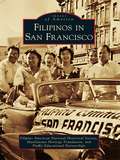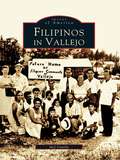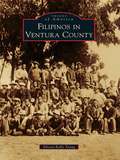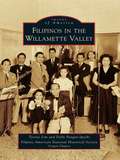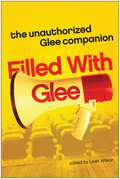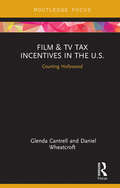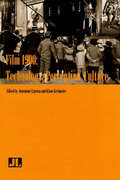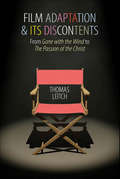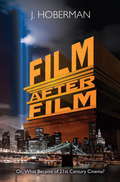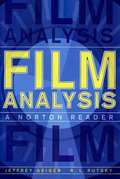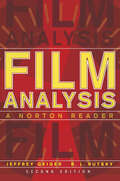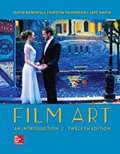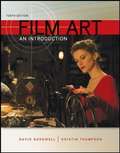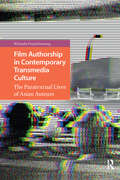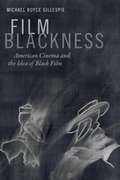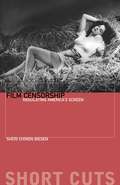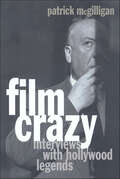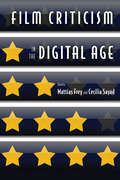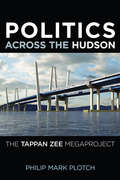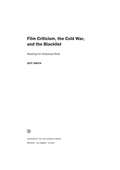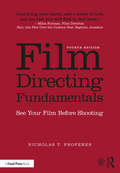- Table View
- List View
Filipinos in San Francisco (Images of America)
by Pin@y Educational Partnerships Filipino American National Historical Society Manilatown Heritage FoundationTens of thousands of Filipinos who have lived, worked, and raised families for over five generations in this unique city stake their rightful claim to more than a century of shared history in San Francisco. The photographs herein attest to the early arrivals, who came as merchant mariners, businesspeople, scholars, and musicians, as well as agricultural and domestic workers. But their story has often been ignored, told incompletely by others, and edited too selectively by many. The Filipino American experience both epitomizes and defies the traditional immigrant storyline, and these pictures honestly and respectfully document the fruits of their labors, the products of their perseverance, and, at times, their resistance to social exclusion and economic suppression.
Filipinos in Vallejo (Images of America)
by Mel OrpillaFilipinos came to Vallejo as early as 1912, and some families here can count five generations back to their roots in the Philippines. Many came to Mare Island Naval Shipyard, where Filipinos found steady, well-paying jobs that spared them from menial work and stoop labor in the fields of California. With each major conflict of the 20th century, and finally with the relaxation of immigration quotas in 1965, waves of Filipino newcomers arrived on these shores. They advanced in their work at the shipyards, settled down, and started families, buying homes and establishing successful businesses. Now this active, politically empowered Filipino community numbers in the tens of thousands, yet traditional histories ignore its contribution to Vallejo's heritage.
Filipinos in Ventura County
by Elnora Kelly TayagFilipino immigrants came to Ventura County in the 1920s, beginning American lives mostly as farm laborers in work camps, notably the Arneill Ranch and Springville Ranch in Camarillo. They organized early societies like the Filipino Brotherhood Association of Ventura County, the Jordan Lodge 604 Legionarios del Trabajo, the Caballeros de Dimas Alang, the Filipino Optimist Club, and the Filipino Community of Ventura County. During World War II, Filipinos served in the 1st and 2nd Filipino Infantry Regiments of the U.S. Army. The omnipresence of the U.S. Navy in coastal Ventura prodded many second- and third-generation Filipinos to serve their country in Korea, Vietnam, Desert Storm, and the Persian Gulf. Today the same spirit of community engagement is illustrated in the 26 local Filipino organizations all under the umbrella of the Filipino American Council, which celebrates history, community, and culture.
Filipinos in the Willamette Valley
by Dolly Pangan-Specht Tyrone Lim Filipino American National Historical Society - Oregon ChapterTucked among the great pioneer destinations on the Oregon Trail is the fertile agricultural area of the Willamette Valley. Today the valley forms the cultural and political heart of Oregon and is home to three-quarters of the state's population. The beginning of the 20th century saw the entrance of Filipinos into the valley, arriving from vegetable farms in California and Washington, fish canneries in Alaska, and from the pineapple and sugar plantations in Hawaii. At the same time, the U.S. territorial government in the Philippines started sponsoring Filipino students, beginning in 1903, to study in the United States. Oregon's two biggest centers of education, today's University of Oregon in Eugene and Oregon State University in Corvallis, became home to Filipinos from the emerging independent Philippine nation. They were mostly male, the children of wealthy Filipinos who had connections. Most of them returned to the Philippines upon graduation; some stayed and created a new life in America.
Filled with Glee: The Unauthorized Glee Companion
by Leah WilsonIs Sue is the true driving force behind Glee? Who is the real alpha male in New Directions? Why do we really keep coming back to Glee week after week? From its quirky character insights to its inspirational, funny, and touching stories from fellow gleeks, Filled with Glee is the perfect companion for the fan who can't get enough Glee. Other standout sections include: A guide to putting together a glee club in your own school or community An index of Glee song and musical references, by episode Biographies of main and guest actors' musical theater backgrounds (and where and when they've worked together before)
Film & TV Tax Incentives in the U.S.: Courting Hollywood (Routledge Studies in Media Theory and Practice)
by Glenda Cantrell Daniel WheatcroftEntertainment tax incentives are one of the greatest tools in the arsenal of filmmaking. They pay a portion of production expenditures back to the filmmaker, while creating powerful economic engines for the states who implement them properly. They are high in the list of considerations for executives to sign off before a movie receives the go-ahead for production, even to the point of dictating the location of where a production is filmed. Yet, they are misunderstood by the filmmakers who use them, the politicians who create them, the economists who measure them, and even the scholars who study them. This book puts all the pieces together in a comprehensive look at how the entertainment industry works, how it uses incentives, and how incentives can benefit a filmmaker – or a state.
Film 1900: Technology, Perception, Culture
by Klaus Kreimeier Annemone LigensaThe current digital revolution has sparked a renewed interest in the origins and trajectory of modern media, particularly in the years around 1900 when the technology was rapidly developing. This collection aims to broaden our understanding of early cinema as a significant innovation in media history. Joining traditional scholarship with fresh insights from a variety of disciplines, this book explains the aesthetic and institutional characteristics in early cinema within the context of the contemporary media landscape. It also addresses transcultural developments such as scientific revolutions, industrialization, urbanization, and globalization, as well as differing attitudes toward modernization. Film 1900 is an important reassessment of early cinema's position in cultural history.
Film Adaptation and Its Discontents: From Gone with the Wind to The Passion of the Christ
by Thomas LeitchMost books on film adaptation—the relation between films and their literary sources—focus on a series of close one-to-one comparisons between specific films and canonical novels. This volume identifies and investigates a far wider array of problems posed by the process of adaptation. Beginning with an examination of why adaptation study has so often supported the institution of literature rather than fostering the practice of literacy, Thomas Leitch considers how the creators of short silent films attempted to give them the weight of literature, what sorts of fidelity are possible in an adaptation of sacred scripture, what it means for an adaptation to pose as an introduction to, rather than a transcription of, a literary classic, and why and how some films have sought impossibly close fidelity to their sources. After examining the surprisingly divergent fidelity claims made by three different kinds of canonical adaptations, Leitch's analysis moves beyond literary sources to consider why a small number of adapters have risen to the status of auteurs and how illustrated books, comic strips, video games, and true stories have been adapted to the screen. The range of films studied, from silent Shakespeare to Sherlock Holmes to The Lord of the Rings, is as broad as the problems that come under review.
Film After Film
by J. HobermanOne of the world's most erudite and entertaining film critics on the state of cinema in the post-digital--and post-9/11--age. This witty and allusive book, in the style of classic film theorists/critics like André Bazin and Siegfried Kracauer, includes considerations of global cinema's most important figures and films, from Lars von Trier and Zia Jiangke to WALL-E, Avatar and Inception.
Film Analysis: A Norton Reader
by Jeffrey Geiger R. L. RutskyContributors examine American, European, and international films as artifacts of their times, as indicators of changes and innovations in ways of thinking about and approaching reality, and as influences upon each other and on the viewer.
Film Analysis: A Norton Reader (Second Edition)
by Jeffrey Geiger R. L. RutskyFifty essays on fifty films—by a who’s-who of film studies. Film Analysis offers concise analyses of fifty diverse and historically significant films—each written exclusively for the text by a leading scholar. Written with the undergraduate in mind, the essays are clear, readable, and great models for students to follow in helping them to hone their own writing. The Second Edition includes six new essays, a new, detailed guide to writing film analysis, and an extensive, up-to-date glossary of critical film terms. This purchase offers access to the digital ebook only.
Film Art: An Introduction
by Jeff Smith David Bordwell Kristin ThompsonFilm is an art form with a language and an aesthetic all its own. Since 1979, David Bordwell, Kristin Thompson and now, Co-Author, Jeff Smith's Film Art has been the best-selling and most widely respected introduction to the analysis of cinema. Taking a skills-centered approach supported by examples from many periods and countries, the authors help students develop a core set of analytical skills that will enrich their understanding of any film, in any genre. In-depth examples deepen students' appreciation for how creative choices by filmmakers affect what viewers experience and how they respond. Film Art is generously illustrated with more than 1,000 frame enlargements taken directly from completed films, providing concrete illustrations of key concepts. Along with updated examples and expanded coverage of digital filmmaking, the twelfth edition of Film Art delivers SmartBook, first and only adaptive reading experience currently available, designed to help students stay focused, maximize study time and retain basic concepts.
Film Art: An Introduction (10th Edition)
by David Bordwell Kristin ThompsonFilm is an art form with a language and an aesthetic all its own. Since 1979, David Bordwell and Kristin Thompson's Film Art has been the best-selling and most widely respected introduction to the analysis of cinema. Taking a skills-centered approach supported by examples from many periods and countries, the authors help students develop a core set of analytical skills that will enrich their understanding of any film, in any genre. In-depth examples deepen students' appreciation for how creative choices by filmmakers affect what viewers experience and how they respond.
Film Authorship in Contemporary Transmedia Culture: The Paratextual Lives of Asian Auteurs (Transmedia)
by Wikanda PromkhuntongFilm Authorship in Contemporary Transmedia Culture: The Paratextual Lives of Asian Auteurs examines film authorship in the transmedia era whereby film directors have become public figures through a wide range of textual, material, and performative practices. The book draws on the notion of paratext and its related term – palimpsest – to bring forth the idea of self-reflexive authorship as a method of examining the mediated past, present, and afterlife of East Asian filmmakers. The first part of the book pays attention to materials surrounding film festivals, multi-platform distribution, and cinephile/fan creative practices, which have been created, rewritten, and shared to foster and problematize the reputations of selected filmmakers. The second part examines alternative modes of self-projections and creative productions that address the filmmakers’ sense of selves and relations with the industry and the public. Across different chapters, discourses surrrounding film authorship and East Asian cinema are revisited and expanded to highlight its multiple histories and possible futures.
Film Blackness: American Cinema and the Idea of Black Film
by Michael Boyce GillespieIn Film Blackness Michael Boyce Gillespie shifts the ways we think about black film, treating it not as a category, a genre, or strictly a representation of the black experience but as a visual negotiation between film as art and the discursivity of race. Gillespie challenges expectations that black film can or should represent the reality of black life or provide answers to social problems. Instead, he frames black film alongside literature, music, art, photography, and new media, treating it as an interdisciplinary form that enacts black visual and expressive culture. Gillespie discusses the racial grotesque in Ralph Bakshi's Coonskin (1975), black performativity in Wendell B. Harris Jr.'s Chameleon Street (1989), blackness and noir in Bill Duke's Deep Cover (1992), and how place and desire impact blackness in Barry Jenkins's Medicine for Melancholy (2008). Considering how each film represents a distinct conception of the relationship between race and cinema, Gillespie recasts the idea of black film and poses new paradigms for genre, narrative, aesthetics, historiography, and intertextuality.
Film Censorship: Regulating America's Screen (Short Cuts)
by Sheri Chinen BiesenFilm Censorship is a concise overview of Hollywood censorship and efforts to regulate American films. It provides a lean introductory survey of U.S. cinema censorship from the pre-Code years and classic studio system Golden Age—in which film censorship thrived—to contemporary Hollywood. From the earliest days of cinema, movies faced controversy over screen images and threats of censorship. This volume draws extensively on primary research from motion picture archives to unveil the fascinating behind-the-scenes history of cinema censorship and explore how Hollywood responded to censorial constraints on screen content in a changing American cultural and industrial landscape.This primer on American film censorship considers the historical evolution of motion-picture censorship in the United States spanning the Jazz Age Prohibition era, lobbying by religious groups against Hollywood, industry self-censorship for the Hays Office, federal propaganda efforts during wartime, easing of regulation in the 1950s and 1960s, the MPAA ratings system, and the legacy of censorship in later years. Case studies include The Outlaw, The Postman Always Rings Twice, Scarface, Double Indemnity, Psycho, Bonnie and Clyde, Midnight Cowboy, and The Exorcist, among many others.
Film Comedy and the American Dream (Routledge Advances in Film Studies)
by Zach SandsFilm Comedy and the American Dream is an examination of national identity in the era of the American superpower as projected in popular comedic films that center on issues of upward mobility. It is the story of what made audiences laugh and why, and what this says about the changing shape of the American Dream from the end of the Second World War through the first part of the twenty-first century. Through a combination of narrative and thematic analyses of popular comedic films, contextualized within a dynamic historical framework, the book traces the increasing disillusionment with this central ideology in the face of multiple forms of systemic exclusion. It argues that film comedy is a major component of the discourse surrounding the American Dream because these movies often evoke humor by highlighting the incongruities that exist between the ideals that define this nation versus the actual lived experiences of its citizens.
Film Crazy: Interviews with Hollywood Legends
by Patrick McGilliganIn Film Crazy, McGilligan shares some of his fascinating interviews with screen luminaries from his salad days as a young journalist working the Hollywood beat. He rides the presidential campaign bus with Ronald Reagan, visits Alfred Hitchcock on the set of the Master of Suspense's last film, "Family Plot," meets George Stevens at the Brown Derby and conducts the last interview with the director of "Shane" and "Giant." Other interview subjects captured for posterity include rough-and-ready pioneer directors William Wellman and Raoul Walsh; likeable actor Joel McCrea; actress - and the only female director of her era - Ida Lupino; French legend Rene Clair; and lowly-contract-writer-turned-studio-mogul Dore Schary. Film Crazy is a must for film students, scholars and professionals.
Film Criticism in the Digital Age
by Greg Taylor Maria San Filippo Noah Tsika Nick James Mattias Frey Cecilia Sayad Giacomo Manzoli Daniel Mcneil Outi Hakola Anne Hurault-Paupe Thomas Elsaesser Paolo Noto Armond White Jasmina KallayOver the past decade, as digital media has expanded and print outlets have declined, pundits have bemoaned a "crisis of criticism" and mourned the "death of the critic." Now that well-paying jobs in film criticism have largely evaporated, while blogs, message boards, and social media have given new meaning to the saying that "everyone's a critic," urgent questions have emerged about the status and purpose of film criticism in the twenty-first century. In Film Criticism in the Digital Age, ten scholars from across the globe come together to consider whether we are witnessing the extinction of serious film criticism or seeing the start of its rebirth in a new form. Drawing from a wide variety of case studies and methodological perspectives, the book's contributors find many signs of the film critic's declining clout, but they also locate surprising examples of how critics--whether moonlighting bloggers or salaried writers--have been able to intervene in current popular discourse about arts and culture. In addition to collecting a plethora of scholarly perspectives, Film Criticism in the Digital Age includes statements from key bloggers and print critics, like Armond White and Nick James. Neither an uncritical celebration of digital culture nor a jeremiad against it, this anthology offers a comprehensive look at the challenges and possibilities that the Internet brings to the evaluation, promotion, and explanation of artistic works.
Film Criticism in the Digital Age
by Mattias Frey Cecilia SayadOver the past decade, as digital media has expanded and print outlets have declined, pundits have bemoaned a "crisis of criticism" and mourned the "death of the critic. " Now that well-paying jobs in film criticism have largely evaporated, while blogs, message boards, and social media have given new meaning to the saying that "everyone's a critic," urgent questions have emerged about the status and purpose of film criticism in the twenty-first century. In Film Criticism in the Digital Age, ten scholars from across the globe come together to consider whether we are witnessing the extinction of serious film criticism or seeing the start of its rebirth in a new form. Drawing from a wide variety of case studies and methodological perspectives, the book's contributors find many signs of the film critic's declining clout, but they also locate surprising examples of how critics--whether moonlighting bloggers or salaried writers--have been able to intervene in current popular discourse about arts and culture. In addition to collecting a plethora of scholarly perspectives, Film Criticism in the Digital Age includes statements from key bloggers and print critics, like Armond White and Nick James. Neither an uncritical celebration of digital culture nor a jeremiad against it, this anthology offers a comprehensive look at the challenges and possibilities that the Internet brings to the evaluation, promotion, and explanation of artistic works.
Film Criticism, the Cold War, and the Blacklist
by Jeff SmithFilm Criticism, the Cold War, and the Blacklist examines the long-term reception of several key American films released during the postwar period, focusing on the two main critical lenses used in the interpretation of these films: propaganda and allegory. Produced in response to the hearings held by the House Committee on Un-American Activities (HUAC) that resulted in the Hollywood blacklist, these films' ideological message and rhetorical effectiveness was often muddled by the inherent difficulties in dramatizing villains defined by their thoughts and belief systems rather than their actions. Whereas anti-Communist propaganda films offered explicit political exhortation, allegory was the preferred vehicle for veiled or hidden political comment in many police procedurals, historical films, Westerns, and science fiction films. Jeff Smith examines the way that particular heuristics, such as the mental availability of exemplars and the effects of framing, have encouraged critics to match filmic elements to contemporaneous historical events, persons, and policies. In charting the development of these particular readings, Film Criticism, the Cold War, and the Blacklist features case studies of many canonical Cold War titles, including The Red Menace, On the Waterfront, The Robe, High Noon, and Invasion of the Body Snatchers.
Film Dialogue
by Ed. Jeff JaeckleFilm Dialogue is the first anthology in film studies devoted to the topic of language in cinema, bringing together leading and emerging scholars to discuss the aesthetic, narrative, and ideological dimensions of film speech that have largely gone unappreciated and unheard. Consisting of thirteen essays divided into three sections: genre, auteur theory, and cultural representation, Film Dialogue revisits and reconfigures several of the most established topics in film studies in an effort to persuade readers that "spectators" are more accurately described as "audiences," that the gaze has its equal in eavesdropping, and that images are best understood and appreciated through their interactions with words. Including an introduction that outlines a methodology of film dialogue study and adopting an accessible prose style throughout, Film Dialogue is a welcome addition to ongoing debates about the place, value, and purpose of language in cinema.
Film Dialogue
by Jeff JaeckleFilm Dialogue is the first anthology in film studies devoted to the topic of language in cinema, bringing together leading and emerging scholars to discuss the aesthetic, narrative, and ideological dimensions of film speech.
Film Directing Fundamentals
by Nicholas ProferesFilm Directing Fundamentals gives the novice director an organic methodology for realizing on the screen the full dramatic possibility of a screenplay. Unique among directing books, this book provides clear-cut ways to translate a script to the screen. Using the script as a blueprint, the reader is led through specific techniques to analyze and translate its components into a visual story. A sample screenplay is included that explicates the techniques. The book assumes no knowledge and thus introduces basic concepts and terminology.Appropriate for screenwriters, aspiring directors and filmmakers, Film Directing Fundamentals helps filmmakers bring their story to life on screen.
Film Directing Fundamentals: See Your Film Before Shooting
by Nicholas T. ProferesFilm Directing Fundamentals gives the novice director an organic methodology for realizing on-screen the full dramatic possibility of a screenplay. Unique among directing books, Nicholas Proferes provides clear-cut ways to translate a script to the screen. Using the script as a blueprint, the reader is led through specific techniques to analyze and translate its components into a visual story. A sample screenplay is included that explicates the techniques discussed. Written for both students and entry-level professionals, the book assumes no knowledge and introduces basic concepts and terminology. Appropriate for screenwriters, aspiring directors and filmmakers, Film Directing Fundamentals helps filmmakers bring their story to life on screen. This fourth edition is updated with a new foreword by Student Academy Award-winner Jimmy Keyrouz, who studied with author Nicholas Proferes, as well as an enhanced companion website by Laura J. Medina, available at www.routledge.com/cw/proferes, which features new supplemental material for both instructors and students, including two new analyses of contemporary films—Wendy and Lucy (2008) and Moonlight (2016)—study questions, suggested assignments and exercises, as well as the instructor’s manual written by Proferes in 2008.
